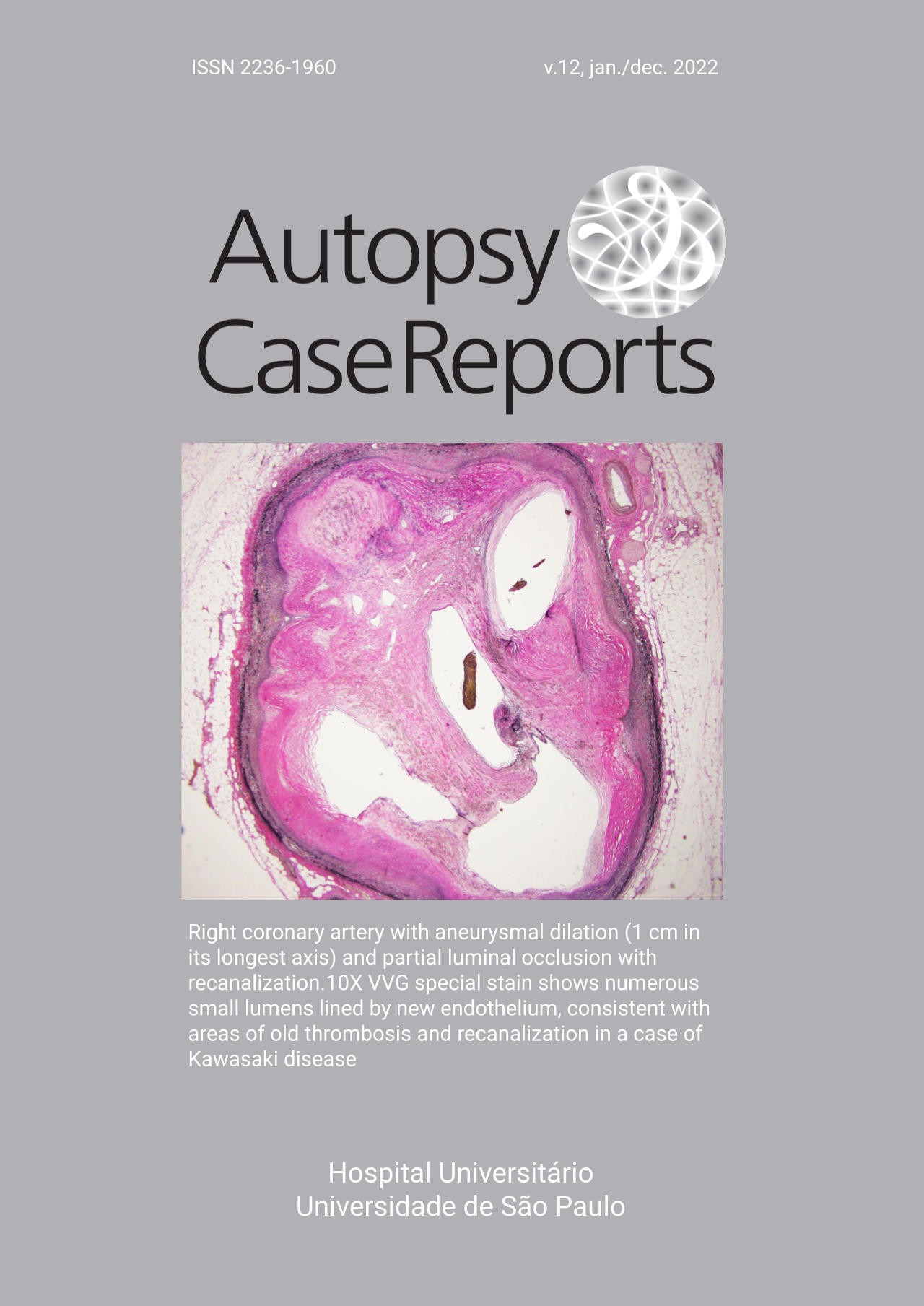Myoid differentiation in dermatofibrosarcoma protuberans and its fibrosarcomatous variant: 10 years’ experience in a tertiary hospital
DOI:
https://doi.org/10.4322/acr.2021.368Keywords:
Dermatofibrosarcoma, Antigens, CD34, Muscle, SmoothAbstract
Dermatofibrosarcoma protuberans (DFSP) is a relatively rare, locally aggressive, and dermal-based fibroblastic tumor. There are several histological variants, in which the usual emphasis is on fibrosarcomatous DFSP, as it acquires metastatic potential. Myoid differentiation in DFSP is rare, and more often found in fibrosarcomatous DFSP. Myoid differentiation is defined as tumor cells with brightly eosinophilic cytoplasm, well-defined cytoplasmic margins, and vesicular nuclei. In this study, we aim at characterizing the immunostaining pattern regarding myoid differentiation in DFSP, and discuss the potential pitfall in making the diagnosis. A total of ten cases of DFSP were found in the past ten years in our hospital. Two of them show focal myoid differentiation, including the only case of fibrosarcomatous DFSP. Around 5% of the tumor area in the traditional DFSP case shows myoid differentiation, while around 10% of the tumor area in fibrosarcomatous DFSP shows myoid differentiation. The myoid areas show positive staining, albeit patchy to focal, for smooth muscle markers, including smooth muscle actin, muscle-specific actin, caldesmon, and calponin. Staining for CD34, in those areas, is weak or negative. This may create diagnostic difficulty with smooth muscle tumors or myofibroblastic lesions, especially in a small biopsy sample. In difficult cases, the detection of COL1A1-PDGFB fusion by fluorescence in situ hybridization is helpful, as this is a characteristic chromosomal translocation found in the large majority of DFSP.
Downloads
References
World Health Organization (WHO). WHO Classification of Tumors of Soft Tissue and Bone. 5th ed. Geneva: WHO; 2020.
Criscione VD, Weinstock MA. Descriptive epidemiology of dermatofibrosarcoma protuberans in the United States, 1973 to 2002. J Am Acad Dermatol. 2007;56(6):968-73. http://dx.doi.org/10.1016/j.jaad.2006.09.006. PMid:17141362.
Monnier D, Vidal C, Martin L, et al. Dermatofibrosarcoma protuberans: a population-based cancer registry descriptive study of 66 consecutive cases diagnosed between 1982 and 2002. J Eur Acad Dermatol Venereol. 2006;20(10):1237-42. http://dx.doi.org/10.1111/j.1468-3083.2006.01780.x. PMid:17062038.
Iqbal CW, St. Peter S, Ishitani MB. Pediatric dermatofibrosarcoma protuberans: multi-institutional outcomes. J Surg Res. 2011;170(1):69-72. http://dx.doi.org/10.1016/j.jss.2011.01.042. PMid:21429521.
Terrier-Lacombe MJ, Guillou L, Maire G, et al. Dermatofibrosarcoma protuberans, giant cell fibroblastoma, and hybrid lesions in children: clinicopathologic comparative analysis of 28 cases with molecular data--a study from the French Federation of Cancer Centers Sarcoma Group. Am J Surg Pathol. 2003;27(1):27-39. http://dx.doi.org/10.1097/00000478-200301000-00004. PMid:12502925.
McKee PH, Fletcher CD. Dermatofibrosarcoma protuberans presenting in infancy and childhood. J Cutan Pathol. 1991;18(4):241-6. http://dx.doi.org/10.1111/j.1600-0560.1991.tb01230.x. PMid:1939782.
Jafarian F, McCuaig C, Kokta V, Laberge L, Ben Nejma B. Dermatofibrosarcoma protuberans in childhood and adolescence: report of eight patients. Pediatr Dermatol. 2008;25(3):317-25. http://dx.doi.org/10.1111/j.1525-1470.2008.00674.x. PMid:18577035.
Leake JF, Buscema J, Cho KR, Currie JL. Dermatofibrosarcoma protuberans of the vulva. Gynecol Oncol. 1991;41(3):245-9. http://dx.doi.org/10.1016/0090-8258(91)90317-X. PMid:1869103.
Dickson BC, Hornick JL, Fletcher CDM, et al. Dermatofibrosarcoma protuberans with a novel COL6A3-PDGFD fusion gene and apparent predilection for breast. Genes Chromosomes Cancer. 2018;57(9):437-45. http://dx.doi.org/10.1002/gcc.22663. PMid:30014607.
Shah KK, McHugh JB, Folpe AL, Patel RM. Dermatofibrosarcoma protuberans of distal extremities and acral sites: a clinicopathologic analysis of 27 cases. Am J Surg Pathol. 2018;42(3):413-9. http://dx.doi.org/10.1097/PAS.0000000000000998. PMid:29240584.
Fletcher CD, Evans BJ, MacArtney JC, Smith N, Wilson Jones E, McKee PH. Dermatofibrosarcoma protuberans: a clinicopathological and immunohistochemical study with a review of the literature. Histopathology. 1985;9(9):921-38. http://dx.doi.org/10.1111/j.1365-2559.1985.tb02878.x. PMid:3840767.
Calonje E, Fletcher CD. Myoid differentiation in dermatofibrosarcoma protuberans and its fibrosarcomatous variant: clinicopathologic analysis of 5 cases. J Cutan Pathol. 1996;23(1):30-6. http://dx.doi.org/10.1111/j.1600-0560.1996.tb00774.x. PMid:8720984.
Mentzel T, Beham A, Katenkamp D, Dei Tos AP, Fletcher CD. Fibrosarcomatous (“high-grade”) dermatofibrosarcoma protuberans: clinicopathologic and immunohistochemical study of a series of 41 cases with emphasis on prognostic significance. Am J Surg Pathol. 1998;22(5):576-87. http://dx.doi.org/10.1097/00000478-199805000-00009. PMid:9591728.
Morimitsu Y, Hisaoka M, Okamoto S, Hashimoto H, Ushijima M. Dermatofibrosarcoma protuberans and its fibrosarcomatous variant with areas of myoid differentiation: a report of three cases. Histopathology. 1998;32(6):547-51. http://dx.doi.org/10.1046/j.1365-2559.1998.00428.x. PMid:9675594.
Karanian M, Pérot G, Coindre JM, Chibon F, Pedeutour F, Neuville A. Fluorescence in situ hybridization analysis is a helpful test for the diagnosis of dermatofibrosarcoma protuberans. Mod Pathol. 2015;28(2):230-7. http://dx.doi.org/10.1038/modpathol.2014.97. PMid:25081750.
Italiano A, Di Mauro I, Rapp J, et al. Clinical effect of molecular methods in sarcoma diagnosis (GENSARC): a prospective, multicentre, observational study. Lancet Oncol. 2016;17(4):532-8. http://dx.doi.org/10.1016/S1470-2045(15)00583-5. PMid:26970672.
Downloads
Published
Issue
Section
License
Copyright (c) 2022 Autopsy and Case Reports

This work is licensed under a Creative Commons Attribution 4.0 International License.
Copyright
Authors of articles published by Autopsy and Case Report retain the copyright of their work without restrictions, licensing it under the Creative Commons Attribution License - CC-BY, which allows articles to be re-used and re-distributed without restriction, as long as the original work is correctly cited.



